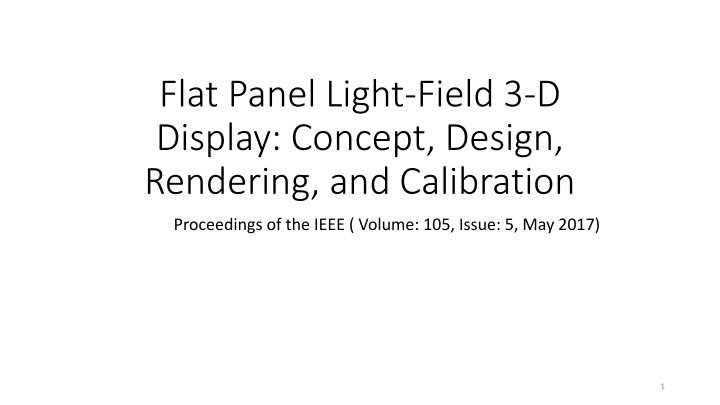
Innovative Flat Panel Light Field 3D Display Design
Explore the groundbreaking concept, design, rendering, and calibration of a Flat Panel Light-Field 3-D Display as presented in the IEEE Proceedings. Discover the evolution from traditional autostereoscopic displays, challenges, proposed 3D model, prototyping, rendering algorithms, calibration techniques, and the significance of Multiview Display versus Integral Image Display. Delve into the intricacies of the proposed method, encompassing unique design elements, lens configurations, viewpoints, resolution enhancements, rendering algorithms, and calibration aspects for enhanced visual experiences.
Download Presentation

Please find below an Image/Link to download the presentation.
The content on the website is provided AS IS for your information and personal use only. It may not be sold, licensed, or shared on other websites without obtaining consent from the author. If you encounter any issues during the download, it is possible that the publisher has removed the file from their server.
You are allowed to download the files provided on this website for personal or commercial use, subject to the condition that they are used lawfully. All files are the property of their respective owners.
The content on the website is provided AS IS for your information and personal use only. It may not be sold, licensed, or shared on other websites without obtaining consent from the author.
E N D
Presentation Transcript
Flat Panel Light-Field 3-D Display: Concept, Design, Rendering, and Calibration Proceedings of the IEEE ( Volume: 105, Issue: 5, May 2017) 1
Outline Introduction Multiview Display v.s. Integral Image Display Proposed 3D Display model Concept Prototyping Rendering Algorithm Calibration Conclusion 2
Introduction Limitation of current autostereoscopic 3D display Narrow viewing angle Low resolution Multiview Display v.s. Integral Image Display Propose an A3D display design 3
Proposed Method - Design Lens pitch: 32/7 times of a pixel width Lens axis tilts by 1/3 pixel width for every one pixel height 8
Proposed Method - Design The distance between the two view points is 2.7mm (pupil diameter is 4 8 mm) 96 viewpoints with 4.57 times resolution reduce 9
Proposed Method Rendering Algorithm f : focal length D is the designed watching distance 10
Proposed Method Rendering Algorithm x is xR xL that can be calculated by stereo matching algorithms 11
Calibration I: observed image D: panel image S: light transition function H: point spread function B: rectangular function N: noise 12
Calibration p : Lens/barrier pitch : Axis-tiling angle t : Distance between the pixel position and the lens surface : Positional offset d: The distance of the display panel from camera center 13
Blur Issue Blur become severe when the depth increase Solution: Generate ideal pencil beam Eye tracking 14
Conclusion Discuss limitations of current A3D display Propose A3D design with the characteristics of both the multiview display and integral image display Concept and design Rendering Algorithm Calibration Probable solution for blur issue 15
